How to Use Sauna with Rocks: Pro Tips for Placement and Safety
At the heart of every great sauna lies an often overlooked yet essential component: the rocks. These unique stones transform a basic heated room into an authentic sauna experience by emitting radiant heat, infusing aromatic steam, and setting the mood.
Sauna rocks must be used properly to harness their full potential. From sourcing the right type of dense, durable igneous rocks to arranging them meticulously within the heater, every step matters.
In this comprehensive guide, we will walk you through the key techniques on how to use a sauna with rocks to elevate your sauna sessions.
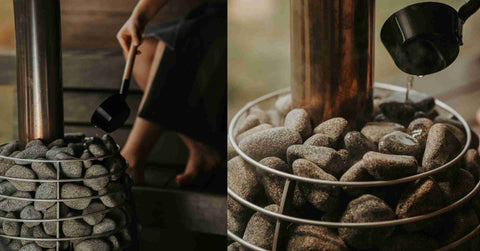
What are Sauna Rocks?
Sauna rocks are an essential component of the traditional Finnish sauna bathing experience, acting as the heart of the sauna heater. These rocks are not just ordinary stones but are specifically chosen for their ability to withstand extreme temperatures and their thermal conductivity.
The primary function of sauna rocks is to store heat from the sauna heater and then radiate this heat into the sauna room, creating a soft, enveloping warmth that is characteristic of a relaxing hot sauna session.
Different Types of Rocks Suitable for Sauna Use
The most commonly used sauna rocks are igneous rocks, formed through the cooling and solidification of magma or lava. The ideal sauna rocks are dense, have excellent heat capacity, and are resistant to thermal shock, which is the ability to withstand sudden changes in temperature without cracking.
Examples include:
- Peridotite: A dense, dark igneous rock that is highly resistant to wear and thermal shock. Its porous nature allows it to hold heat well, making it a popular choice for saunas.
- Vulcanite (or Basalt): Known for its excellent heat retention and distribution, vulcanite is another favored rock for sauna use. It heats up evenly, ensuring a consistent sauna temperature.
- Olivine Diabase: This rock is praised for its exceptional durability and heat retention properties. Its ability to withstand frequent heating and cooling cycles without degradation makes it ideal for regular sauna users.
- Granite: Due to its ability to maintain heat, durable granite rocks are a popular choice for saunas.
Selecting the Right Sauna Rocks
When choosing rocks for your sauna, consider their origin and properties. Natural, uncoated rocks are preferred over-treated or artificial alternatives, as they are more in tune with the traditional sauna experience and less likely to release harmful substances when heated.
The rocks should be free from moisture-absorbing minerals like zeolites, which can explode when heated. Size and shape also matter; a mix of medium to large rocks is ideal, as smaller rocks heat up faster, but larger rocks retain heat longer, providing a balanced sauna environment.
Preparing Your Sauna
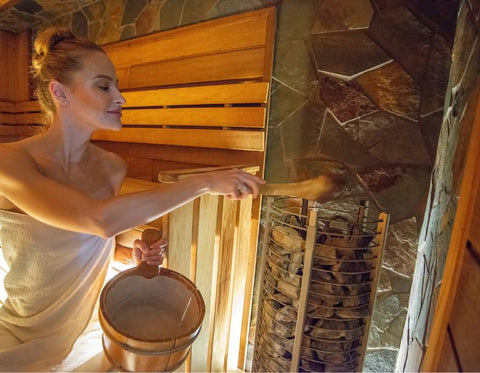
Before enjoying the warmth of a sauna, it's imperative to prepare it properly to ensure safety and clean the sauna. Preparing your sauna involves cleaning, arranging the rocks correctly, and pre-heating the space to the desired temperature.
Cleaning Your Sauna
Start with a clean slate by ensuring your sauna is tidy and hygienic. Remove any dust or debris from the benches, floor, and heater. If you're using a wood-burning sauna stove, ensure the chimney is clear and the stove is clean of ash and soot.
For electric heaters with rocks, check that the heating elements are free of dust. The area around the sauna heaters should be clear.
Arranging Sauna Rocks
Proper placement of sauna rocks is vital for efficient heating and safety. Begin by inspecting the rocks for any signs of wear or cracks, and replacing any that are unsuitable.
When placing the rocks in the sauna heater, ensure they are loosely stacked to allow air to circulate freely. This ensures that the rocks heat evenly and the heat is distributed effectively throughout the sauna.
Avoid packing the rocks too tightly, as this can restrict airflow and lead to overheating or uneven heating.
Pre-Heating Your Sauna
The final step in preparing your sauna is pre-heating it to the desired temperature. The time required to heat a sauna can vary depending on the size of the sauna, the type of heater, and the initial temperature of the steam room.
Generally, it takes between 30 to 60 minutes for a sauna to reach an optimal temperature range of 150°F to 195°F (65°C to 90°C). During this time, the rocks will absorb heat and begin to radiate it into the room, creating the perfect sauna environment.
RELATED TO: How to Choose the Right Electric Sauna Heater with Rocks for Your Needs
How to Use Sauna with Rocks: Placement Techniques
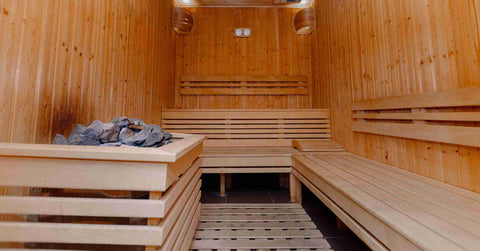
The arrangement of sauna rocks within the heater is not just about aesthetics; it's an important aspect that influences the efficiency of heat distribution, the quality of löyly (the steam produced when water is thrown on the hot rocks), and overall safety. Here's how to master the placement techniques:
Layering the Rocks
Begin with a base layer of larger rocks at the bottom of the heater. These should be substantial enough to support the layers above but spaced enough to allow for adequate airflow. The base layer acts as the foundation, ensuring stability and facilitating the initial heat retention.
Creating Air Channels
As you build up from the base layer, strategically place the rocks to create natural air channels. These channels allow hot air to rise through the heater, ensuring the rocks are heated evenly. The aim is to strike a balance between having enough sauna rocks to retain heat and enough gaps to allow air and heat to circulate freely.
Top Layer and Accessibility
The top layer of rocks is where most of the water will be poured to create löyly, so these rocks need to be exposed and easily accessible. Choose sauna rocks that are flat and smooth for this layer, as they provide a larger surface area for the water to evaporate from and produce steam.
Checking Stability
Once all the rocks are in place, gently shake the heater to ensure there are no loose rocks. Stability is key to preventing rocks from shifting and potentially falling out of the heater, which could pose a safety hazard.
Safety First: Using Sauna Rocks Responsibly
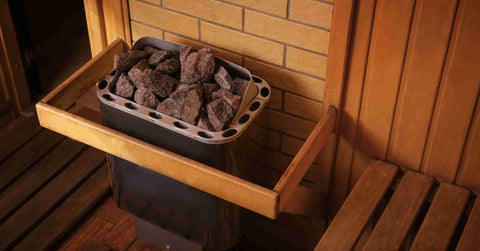
While sauna rocks are central to the traditional sauna experience, their misuse can lead to accidents and injuries. Adhering to safety guidelines ensures a safe and enjoyable sauna session for everyone.
Handling Hot Rocks
Never attempt to rearrange or touch the sauna rocks when they are hot. If you need to adjust the rocks, do so only when the heater is cool and has been turned off for a sufficient period.
Water Pouring Etiquette
When pouring water on the rocks, use a ladle and do it gradually. Pouring or throwing water too much at once can cause the rocks to crack due to thermal shock. It can also create an uncomfortably hot burst of steam, posing a risk of scalding.
Regular Inspection
Regularly inspect your sauna rocks for signs of wear, such as cracking or crumbling. Over time, the repeated heating and cooling cycles can degrade the integrity of the rocks, making them more susceptible to breaking. Replace any damaged rocks promptly to maintain the safety and efficiency of your sauna.
Avoiding Flammable Substances
Ensure that no flammable materials or liquids are used in or around the sauna. This includes avoiding the use of essential oils directly on the rocks, as they can ignite or create uncomfortably intense fumes when heated.
Child and Pet Safety
If children or pets are present, ensure they are supervised at all times in and around the sauna. The heater and rocks can reach extremely high temperatures and pose a burn risk.
Enhancing Your Sauna Experience

Elevating your sauna experience involves engaging all your senses to create a truly relaxing, rejuvenating environment and gain the potential health benefits. Here's how you can enhance your time in the sauna using rocks:
Optimizing Löyly (Sauna Steam Rooms)
Gradual Water Pouring: To create the perfect löyly, gently sprinkle water onto the rocks using a wooden ladle. This allows the water to evaporate slowly, producing a soft, moist heat that envelops the body without being overwhelming.
Temperature and Humidity Balance: Experiment with the right amount of water to find the perfect balance of temperature and humidity for your comfort. Some prefer a dry heat with minimal löyly, while others enjoy a more humid environment.
Aromatic Additions
Essential Oils: Instead of applying oils directly to the sauna rocks (which can be a fire hazard), add a few drops of essential oil to the water in your sauna bucket. When you ladle this water onto the rocks, the air will be infused with the fragrance. Popular choices include eucalyptus for its respiratory benefits and lavender for relaxation.
Herbal Bouquets: Hang fresh or dry herbal bouquets near the sauna heater. The heat will gently release the natural oils and aromas from the herbs, creating a subtle, therapeutic fragrance in the sauna. Birch, pine, and peppermint are traditional choices that offer a refreshing scent.
Lighting and Ambiance
Soft Lighting: Enhance the ambiance with soft, dimmable lighting or LED candles that mimic the flicker of real flames. This can create a serene atmosphere that encourages relaxation.
Soothing Sounds: Background sounds, such as nature tracks, gentle music, or even the silence itself, can help in creating a tranquil environment conducive to relaxation and meditation.
Maintenance and Care of Sauna Stones

Proper maintenance and care of sauna rocks are essential to ensure they perform effectively and safely over time. Here's how you can keep your sauna rocks in top condition:
Regular Cleaning
Removing Dust and Debris: Before heating your sauna, check the rocks for any loose debris or dust that may have accumulated and remove it to prevent any unwanted smells when the rocks are heated.
Rinsing Rocks: Periodically remove the rocks from the heater (when cool) and rinse them with water to remove any built-up sauna residues. This is especially important if you use essential oils or herbs, as residues can accumulate over time.
Inspection and Replacement
Visual Inspection: Regularly inspect your sauna rocks for signs of wear, such as cracks, crumbling, or significant discoloration. These can be indications that the rock's structural integrity is compromised.
Replacement Schedule: Even with no visible signs of wear, consider replacing your sauna rocks every few years, depending on the frequency of sauna use. Continuous heating and cooling cycles can gradually degrade the rocks' effectiveness.
Avoiding Chemical Cleaners
Natural Cleaning Solutions: Avoid using harsh chemical cleaners on your sauna rocks, as they can release harmful fumes when heated. Stick to natural cleaning methods, like rinsing with water or using a mild soap solution for tough residues.
Storing Extra Rocks
Keeping Spares: It's a good idea to have spare rocks on hand to replace any that become damaged. Store these in a dry, clean place so they're ready to use when needed.
Common Mistakes to Avoid
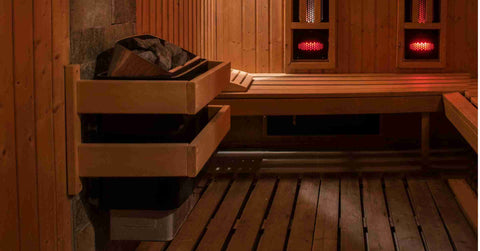
When using a sauna with heated rocks, certain common mistakes can detract from the experience, compromise safety, or even damage your sauna. Being aware of these pitfalls can help you enjoy your sauna sessions to the fullest while maintaining the longevity of your equipment.
Overloading the Sauna Heater
Placing too many rocks in the heater can impede airflow, leading to inefficient heating and potential overheating of the electric elements or wood stove. Ensure there's enough space between rocks for sauna air to circulate.
Using Improper Rocks
Not all rocks are suitable for sauna use. Avoid using river rocks or other porous stones that can absorb water, as they can crack or explode when heated. Stick to dense, igneous rocks like peridotite or vulcanite.
Neglecting Ventilation
Proper ventilation is important in a sauna to replace humid air with fresh air and to ensure efficient oxygen flow. Failing to maintain adequate ventilation can lead to discomfort, excessive humidity, and an unsatisfying sauna experience.
Ignoring Heater Capacity
Overloading the sauna heater with too much water can cause electrical components to fail or wood stoves to cool down too quickly. Be mindful of the heater's water capacity and pour water gradually to create löyly.
Skipping Pre-heating
Jumping into a sauna before it has properly pre-heated can result in a lukewarm and less beneficial experience. Allow enough time for the sauna to reach the desired temperature and for the rocks to store more heat.
Frequently Asked Questions About How to Use Sauna with Rocks
-
What types of rocks are best for sauna use?
The best types of rocks for sauna use are dense, igneous rocks that can withstand high temperatures and rapid changes in temperature without cracking. Peridotite, vulcanite (or basalt), and olivine diabase are among the most preferred due to their excellent heat retention and resistance to thermal shock. These rocks are natural and can efficiently store and radiate heat, enhancing the sauna experience.
-
How should sauna rocks be arranged in the heater?
Sauna rocks should be arranged for sufficient airflow while maximizing heat retention and distribution. The best way is to start with a base layer of larger rocks and build up to smaller ones, ensuring there are gaps to create air channels. The top layer should consist of medium-sized rocks that are easily accessible for adding water over them. The arrangement should be stable to prevent rocks from shifting and potentially causing injury.
-
How often should sauna rocks be replaced?
The frequency of replacing sauna rocks depends on how often the sauna is used and the condition of the rocks. Regular users should inspect their rocks annually for signs of wear, such as cracking or crumbling. Even if no visible signs of deterioration are present, consider replacing the rocks every 2-3 years to ensure optimal performance and safety.
-
Can essential oils be used with sauna rocks?
Yes, essential oils can be used to enhance the sauna experience, but they should not be applied directly to the rocks, as this can be a fire hazard. Instead, add a few drops of essential oil to the water in your sauna bucket. The steam will carry the aroma throughout the sauna when the water is ladled onto the hot rocks. Eucalyptus, lavender, and pine are popular choices for their soothing and refreshing properties.
-
What is the proper way to clean sauna rocks?
Sauna rocks should be cleaned periodically to remove any buildup of residue. This can be done by turning off the sauna, allowing the rocks to cool completely, and then removing them from the heater. Rinse the rocks with water to remove loose debris. Avoid using harsh chemicals or soaps, as these can leave residues that may emit unpleasant odors when heated. If rocks are heavily soiled, a mild soap solution can be used, followed by a thorough rinsing with clean water.

In Summary
Mastering how to use sauna rocks effectively is key to enhancing your sauna experience, ensuring safety, and prolonging the life of your sauna. From selecting the right type of rocks and arranging them correctly for optimal heat distribution to understanding the importance of maintenance and safety protocols, every aspect contributes to a superior and authentic sauna session.
Whether you're a seasoned sauna enthusiast or a newcomer eager to embrace this cherished tradition, the insights shared here will empower you to elevate your sauna sessions to gain potential health benefits.
